It’s often said that any high-performance variant of an otherwise mainstream car originated in the manufacturer’s Skunkworks but this is usually PR bullshit; the point of origin is normally the marketing department, with input from the accountants. The engineers only get involved at a relatively late stage and then spend all their time trying to strong-arm the cash they need to turn a mediocre car into a slightly faster mediocre car.
Of course, there are exceptions. The BMW 2002 was transformed from a worthy-but-dull car into a legendary one thanks to the vision of a couple of senior engineers but that the 2002 stands out in this way is largely because what happened is so rare.
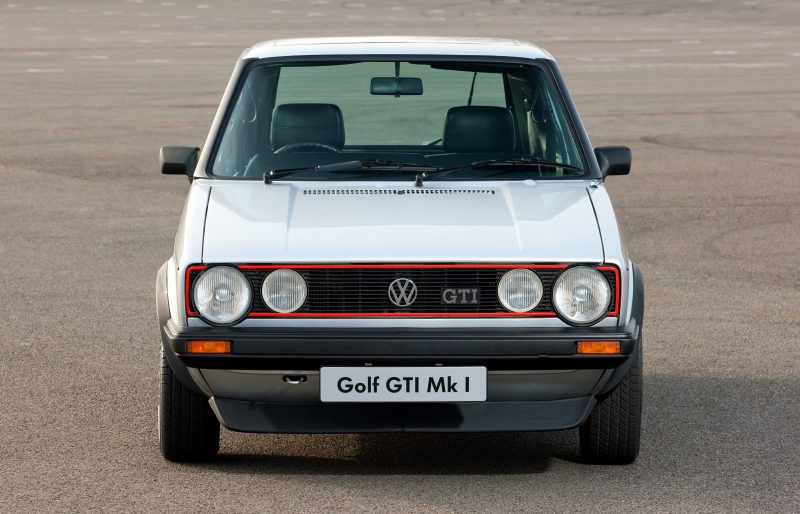
Which is a long-winded way of welcoming the Volkswagen Golf GTI to Patina on this, its 40th birthday. The Golf range was released into an unsuspecting world in 1974 and rapidly gained the approval of absolutely everyone that drove one. Here was a car that was practical, simple, and cheap and, moreover, one that demanded nothing of its driver other than petrol because it stopped, started and cornered with an absence of drama that was astonishing.
That this was so was due to simple engineering done with atypical thoroughness: MacPherson struts, transverse engines, rack-and-pinion steering and even front-wheel-drive were all commonplace but to combine them all in one lightweight, stiff monocoque body was nothing short of genius. The hatchback shape – so common now but still uncommon back in the days when the three-box saloon ruled – offered most of the benefits of an estate car in a rakish, thoroughly modern profile. It was a car that started the job of ushering the public into the 21st century.
Volkswagen then sold it for peanuts and backed the whole package up with previously unheard of levels of reliability, acts that sealed the deal for millions of people across the world. It wouldn’t be an exaggeration to say that the VW Golf/Rabbit almost single-handedly killed the so-called ‘full-size’ car market in North America.
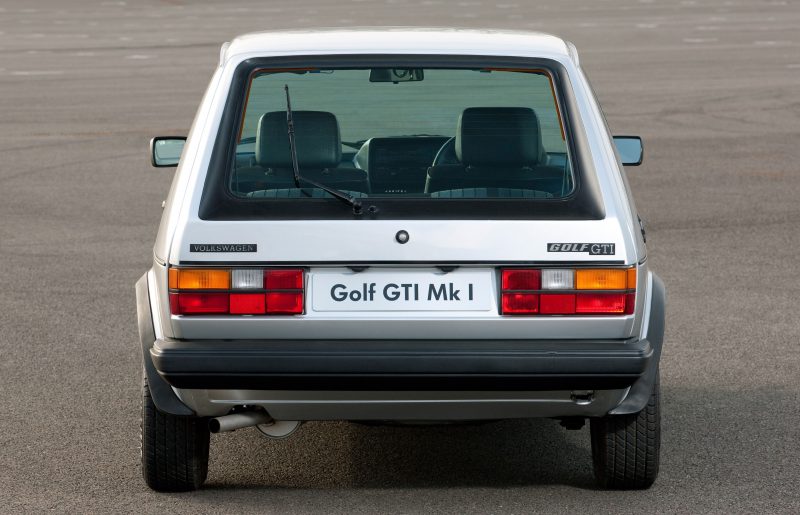
So it was almost inevitable that a bunch of VW engineers would see the promise that the Golf offered. What would happen, they asked themselves, if we lowered and stiffened the suspension a little bit? What about adding fuel injection for reliability and power? Or sports seats to hold the driver a little more firmly? Being engineers, they cut and welded and bolted things together in their spare time and found that the answer to all their questions was a resounding ‘hell yes!’
Incredibly, this soon-to-be well-trodden path was new territory in the small car market. The accountants started to pay attention when they tapped on their calculators for a while before realising that the profit margin the engineers’ car offered was comfortably higher than anything else in the range. The marketing department was unconvinced but then marketing people can usually be safely ignored when they are in conflict with engineers. And anyway, Volkswagen was still a company that engineered things in the seventies; the project was given the green light in 1975 and the car VW provisionally called ‘Sport Golf’ was born.
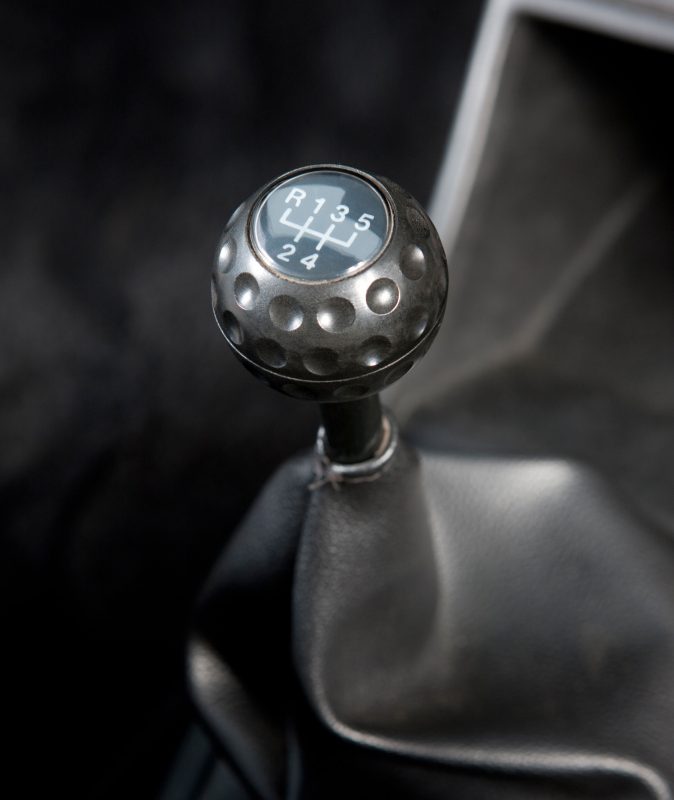
Project Sport Golf
The concept managed to stay reasonably pure, even after the bean-counters and bullshitters weaselled their way in. The suspension was dropped and stiffened a little and a rear anti-roll bar was fitted but the inherent design and geometry was so good that the changes were relatively subtle. A small chin spoiler helped keep the Golf stabile at high speeds and small wheel arch extensions were fitted to cover the slightly wider 175/70 x 13 tyres (on steel rims, at least initially) but that was the extent of the exterior changes bar a matt black sticker that surrounded the rear screen and discreet red trim around the front grille.
Brakes were uprated to ventilated discs at the front but the rear drums were retained, which was later to prove the only significant miscalculation they made. The first cars had a four-speed, close-ratio gearbox (later changed to a five-speed) with the emphasis placed firmly on acceleration rather than top speed.
The interior gained figure hugging Recaro-style seats with a lurid check pattern and a smaller, thicker steering wheel. Oh, and the gear knob was changed to one that looked like a golf ball. Crazy, huh?
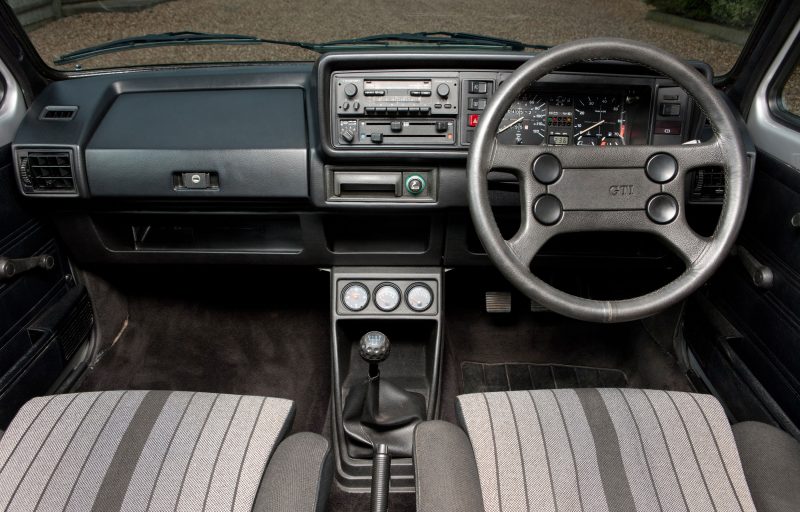
All UK-market Golf GTIs were three-door, and were originally only available in four colours: Diamond Silver, Alpine White, Mars Red and Schwartz Black. Later cars were also being offered in Lhasa Green, Helios Blue and a few (very few) were available in Atlas Grey. All had black stripes along their flanks.
Fuel injection was a path well trodden, at least in bigger, faster and more expensive cars but fitting it to something as cheap and light as the Golf was a revelation and it turned the motor industry’s thinking upside down; small cars were no longer automatically slow and cheap and bought only by people that couldn’t afford anything better.
The engine came from the Audi 80 and fitting Bosch K-Jetronic mechanical fuel injection gave a lively 110bhp (ten more than the OE carburettor engine) or a very respectable power-to-weight ratio of 135bhp/tonne. More importantly, drivability was greatly improved, as was cold-weather starting and fuel economy. The fuel-injected Golf proved that you really could have your cake and eat it.
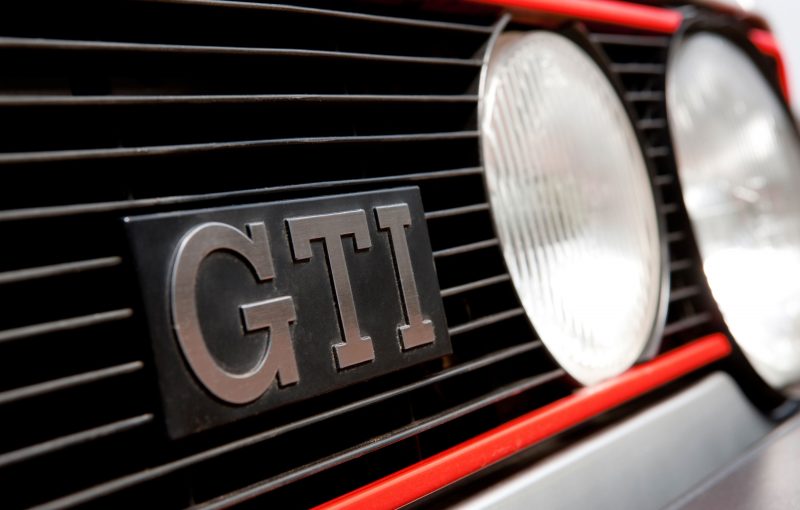
Giving it a name
But what to call it? Calling the Sport Golf a GT, short for Grand Turismo, was an obvious move but the German for ‘injection’ is Einspritzung, so it should have been the GTE. Inexplicably, VW called it the Golf GTI and an iconic name was born.
When the marketing wonks finally came on board they did so with a vengeance, suggesting that the company should build 5,000 units, the number needed to homologate the car for Production Touring Car racing. They was, they argued, the only way give the as-yet-untested Golf GTI an instant credibility boost.
They needn’t have worried as it’s fair to say the new Golf GTI of 1976 did very well without their help. Word of mouth recommendations led to sales volumes that could never have been predicted; from the initial target of 5,000 cars a year – a target that most felt was woefully optimistic – the Golf GTI started selling at the rate of 5,000 a month.
Waiting lists grew, which stimulated demand even further. Young people bought it. But then so did older, affluent people. Racing drivers bought them as did young families. It was, just like the Mini and Range Rover before it, utterly classless. At the time of its death a quarter of all Golfs sold in the UK were GTIs and just under 20,000 found homes here all told.

Model changes
A five-speed gearbox was fitted in 1979, which lowered the 0-60mph time from around 9 seconds to 8.5 while simultaneously edging the top speed up from 111mph to 113mph. Left-hand-drive cars had been imported in small numbers from 1977, but 1979 was the first year in which you could buy a proper, factory built right-hand-drive car, so if you find a four-speed, RHD car you’ve got a very rare beast indeed.
1981 ushered in a far nicer interior thanks to a complete redesign and the use of much better quality plastics and trim and a more tasteful material for the seats. (It also saw the introduction of a red line around the dashboard that, mercifully, didn’t last long.) The rear lights were also changed and while they were certainly more modern they lack the elegance of the earlier versions to my eyes.
The biggest change came in 1983 with the introduction of the 1.8-litre engine. Power rose gently from 110bhp to 112bhp, an on-paper disappointment that was matched by the 8lb/ft increase in torque. And yet, if you’ve been paying attention you’ll be able to guess that the scale of the change was significantly greater than armchair critics will suggest or the (by then uncompetitive) 0-60mph time of 8.2 seconds hinted at.
Because, in the same way as fitting fuel injection made the greatest changes to drivability and the use of a close-ratio gearbox helped acceleration rather than top speed, the extra engine capacity drove the torque peak down, broadening its plateau and making the new Golf GTI a far nicer car to drive, mainly because it was now usefully faster and more flexible in the mid-range. It was also, somewhat counter-intuitively, even more economical.
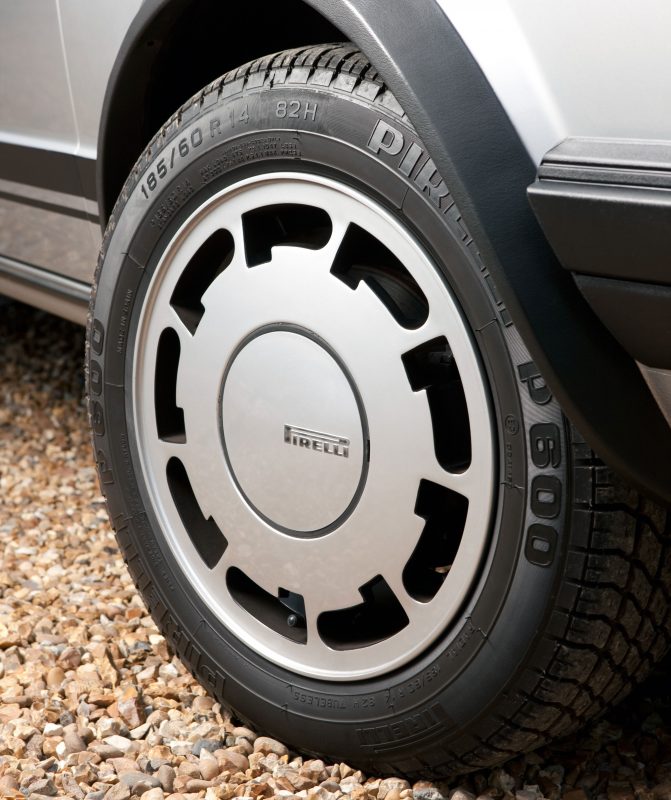
The all-new MK2 Golf arrived in 1984, prompting VW to release the last hurrah Campaign model to get rid of any unsold models. The changes comprised a metal sunroof, twin-headlamps and a set of 14-inch Pirelli alloys shod with 185/60 x 14 tyres. (The latter was famously called the ‘Plus One’ concept, the argument being that if you went up one width and down one profile the rolling circumference of the wheels and tyres (and so speedometer accuracy and gearing) would be maintained.)
These changes might not sound much but these cars are, along with the early, cowled instrument panel 1.6 models, the most sought-after version of an already highly desirable car.
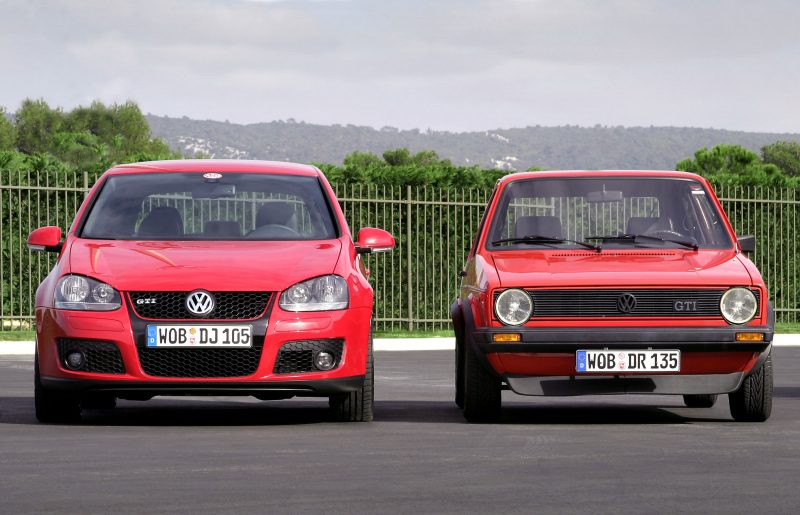
Driving
The early Golf GTIs fairly fizz along the road. The absence of weight – early cars weigh as little as 810kgs – helps, of course but the sheer rev-happy nature of the engine aided and abetted by the close-ration gearbox is what brings them alive. It’s noisy, with wind noise competing for dominance with the engine, but the first sniff of a twisting road will banish any concerns about the Golf’s period-level NVH from your mind.
The steering is sharp (-ish) and the handling is still mightily competent, even if ultra-fast corners see the inside rear wheel cocking its leg, sending the GTI into instant oversteer, albeit in a very controllable form. It rides well, especially when you compare it to the sort of hot hatches we have become accustomed to; 70-series tyres might technically qualify as low-profile, but they aren’t not really and their tall sidewalls do a terrific job of cushioning you from the worst 21st century potholes.
Remember I that I said that the brakes were one of the few engineering oversights? The rear drums are sharp enough when they’re properly adjusted but the automatic adjustors don’t work terribly well, leading to a long pedal travel as the drums are forced from an sluggish resting position against the surface of the drum.
But the drum brakes weren’t the real problem. Left-hand-drive cars had a direct connection between the pedal and the brake servo. They stopped, and they stopped well and they were also easily modulated. Right-hand-drive cars had a tortuous and complex linkage ‘twixt pedal and servo that robbed the driver of confidence and feel. The brakes still worked OK, especially when they were new and properly adjusted, but they never felt as well sorted and inspiring as the rest of the car, a situation that got worse with time as linkages and bushed perished and loosened.
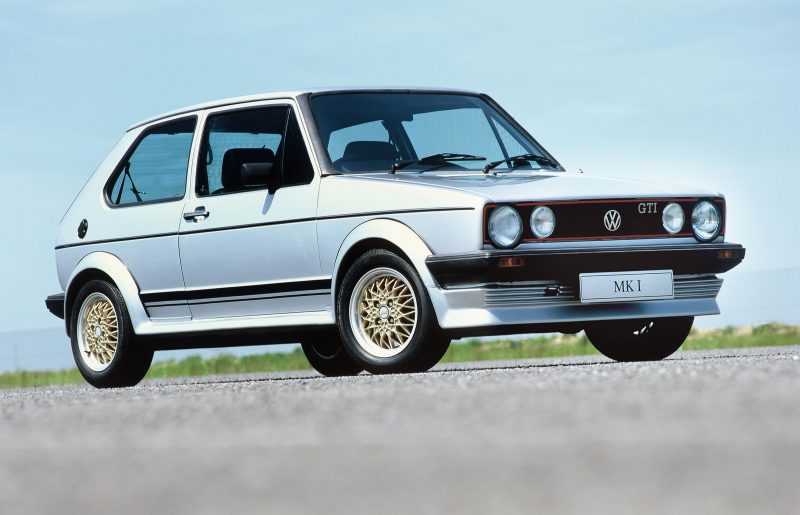
Buying
An awful lot of MK1 Golf GTIs have succumbed to rust. It wasn’t that they were built badly just that even the latest cars are now 33 years old. That the price of early Golf’s dropped to under a grand for a couple of decades didn’t help as it rendered thousands beyond economic repair.
Nor was their situation helped by the fact that those that escaped the scrap man’s crusher yielded ungracefully to the less-than-tender mercies of the customising crowd who slammed them to the ground, installed bigger engines and fitted car stereos so powerful that the bodyshell itself needed reinforcing.
Having said that, many have survived and there are more than a few that are still completely original and with only handful mileage – and prices are lower than you might think (data provided by Patina Price Trends):

I found a 89,000 mile, unmolested Mars Red that needs light fettling for £2,500. Even sub-50,000 mile cars with fsh and in immaculate condition struggle to reach £10,000. There are some chancers out there asking all the money but you’d struggle to pay more than £15,000, even for a concours winner.

Colour doesn’t seem to make a difference to a car’s desirability, so feel free to take your pick. Nor should you be deterred by a car that was modified by one of the original tuners: GTi Engineering, BR Motorsport, or Tim Stiles Racing were all well-respected in their day and a car that has received their tender ministrations (backed up by some provenance that confirms what work was done and by whom) shouldn’t be worth any less than a bog-standard factory car. Whether to buy a car that has been retrofitted with a 16-valve or supercharged G60 engine depends on your own priorities but it sure as hell isn’t going to be as good an investment as a period-correct car.
BTW, extra points will be given to cars with their original radio/cassette player, plus a bonus gold star (and a pint if we ever meet) will be deservedly awarded to anyone who owns a car that still has an aftermarket Fischer cassette holder in the centre console.
Carlton Boyce